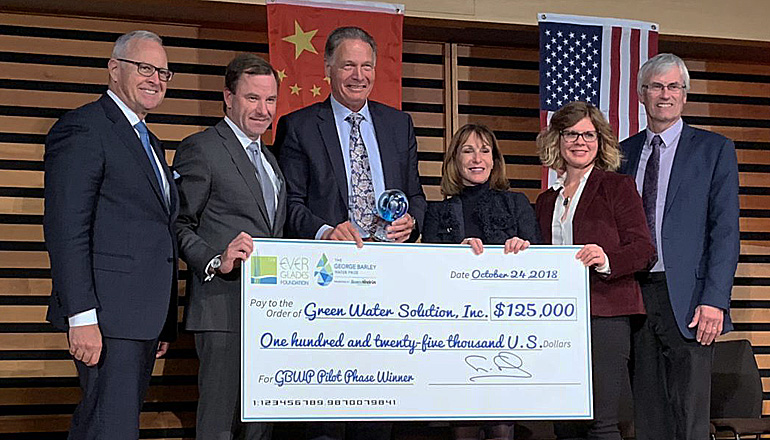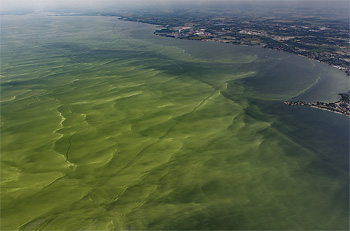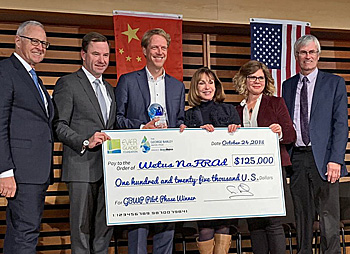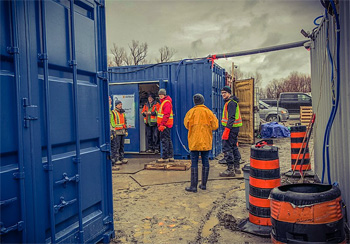Wetsus and Greenwater Solution amongst four finalists Barley prize to combat algae bloom

Following a two-year field test in Canada with nine different technologies to remove low concentration phosphorous from surface water, the four finalists have been announced. Two of the finalists of the George Barley Water Prize are rooted in the Netherlands: research institute Wetsus and watertech supplier Greenwater Solution.
The four finalists and winners of the Stage 3 awards, were announced at the Ontario Water Innovation Week in Toronto, Canada, on 25 October. The finalists will enter the final stage that consists of another 14 months of intensive field testing under moderate and warm weather conditions. The winner of this final stage wins the 10 million US dollar award.
 In many places in the world high phosphorous concentrations lead to bloom of toxic algae that causes problems for the intake of drinking water.
In many places in the world high phosphorous concentrations lead to bloom of toxic algae that causes problems for the intake of drinking water.
Cold weather conditions
In the third phase of the George Barley Water Prize, nine teams of scientists, engineers, and entrepreneurs – narrowed down from an original field of 104 international competitors – have been testing their technologies under cold weather conditions on The Holland Marsh, in Ontario, Canada.
The four remaining teams will now advance to the final phase of the competition, called the “Grand Challenge,” at Lake Jesup, near Orlando, Florida.
Four remaining finalists
The finalists include two Dutch rooted entries:
● Wetsus, Leeuwarden, the Netherlands
With its Nafrad technology using advanced filtration, flocculation, and high-capacity adsorption on a special granular iron-oxide material to push effluent phosphorus levels to extremely low levels, while producing calcium phosphate, an inorganic fertilizer as a byproduct.
● Greenwater Solution, Wellington, Florida (rooted in Dutch company AquaCare)
With its BioPhree system that can remove phosphorus to 10 parts per billion even with very high inputs. The process is scalable, and has been applied in industrial and municipal settings.
 On behalf of Wetsus, Leon Korving (middle) received the 3rd phase award. On top photo is Koos Baas (middle) of GWS receiving his award.
On behalf of Wetsus, Leon Korving (middle) received the 3rd phase award. On top photo is Koos Baas (middle) of GWS receiving his award.
The other two finalists are both from the US:
● University of Idaho
With a reactive filtration system that uses biochar, an iron-oxide adsorption filter, and ozone that can produce food byproducts.
● Leetown Science Center (USGS)
With a mine drainage ochre to develop an iron-oxide filtration bed that can produce a phosphate fertilizer.
Announced as runner up was ZeroPhos, from Nanjing University in Nanjing, China with a late entry, but put forward an extraordinary technology based on lanthanum, a rare earth with remarkable properties.
Best hope
‘These finalists represent our best hope for solving the algae crisis that is choking waterways worldwide’, said Eric Eikenberg, CEO of The Everglades Foundation, which is hosting the competition.
‘These final four teams will need to prove their technologies’ ability to work in both freezing and warm temperatures. This will be their opportunity to showcase the global applicability of their solutions’, Eikenberg added.
 During the 3rd phase, nine teams conducted field tests removing phosphorous from the surface water of Lake Simcoe, Canada, under cold conditions.
During the 3rd phase, nine teams conducted field tests removing phosphorous from the surface water of Lake Simcoe, Canada, under cold conditions.
According to the World Resources Institute, more than 15,000 freshwater bodies in the United States alone are affected by phosphorus pollution.
Runoff from man’s long-standing use of phosphorus-based fertilizers is so extensive, scientists believe, that even if its use were to be eliminated altogether, there is so much of the mineral already stored in water and soil that it would continue to be a serious pollutant, creating algae blooms for decades, if not centuries, to come.
Final phase
'Using today’s technologies, it would cost upward of 3 trillion US dollar to reduce the current worldwide flow of phosphorus by just 10 percent', explained Loren Parra, Director of the George Barley Water Prize.
'Living and working here in Florida, we could certainly benefit from a solution and we are excited, hopeful and anxious to see what comes from the Grand Challenge', Parra said.
This news item was originally published on the website of the George Barley Water Prize.
Read also on this website
● Wetsus enters third phase Barley Water Prize to recover phosphorus from Lake Simcoe, Canada, 12 March 2018
● Wetsus also wins next stage George Barley prize to clean up toxic algae blooms, 27 October 2017
● US and Dutch water sector join forces against harmful algae bloom in Lake Erie, USA, 13 May 2015
● Expertise: Water technology
More information
George Barley Water Prize
www.barleyprize.org
Wetsus
Leeuwarden, the Netherlands
+31 58 284 31 62
www.wetsus.nl
Greenwater Solution (AquaCare)
Wellington, Florida, USA
+1 561 507 0201
www.greenwatersolution.com
Video with engineers at Lake Simcoe, Canada looking back on their 3rd phase pilots, including Miriam Kuiper of GWS/Wetsus.



